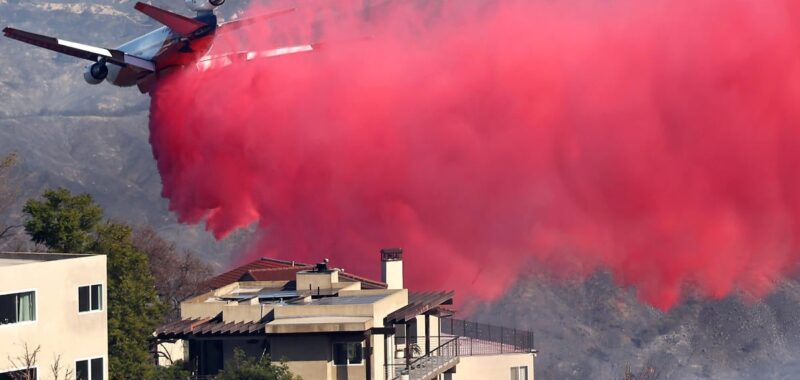Aircraft battling fires raging through the Los Angeles area are dousing the area with more than water: Hundreds of thousands of gallons of hot-pink fire suppressant have been dropped ahead of the flames in a desperate effort to stop them before they destroy more neighborhoods.
The deadly fires have displaced thousands of residents and destroyed more than 12,000 structures since they began last Tuesday, Jan. 7. Four major fires driven by strong Santa Ana winds have charred about 62 square miles, according to Cal Fire.
Fire agencies say the suppressants — most often used to fight forest fires — are an invaluable tool. But what is in them and are they safe?
/ Getty Images
Here’s what to know:
When are fire suppressants used?
The fires are burning quickly through canyons and other rugged areas that are difficult for firefighters on the ground to reach, Cal Fire said.
While fire suppressants can be very effective, they do have limitations, the agency said. Strong winds can make it too dangerous to fly at the low altitudes needed for drops and can dissipate the retardant before it hits the ground.
Besides Cal Fire, multiple agencies have dropped fire retardant and water, including the U.S. Forest Service, the Los Angeles and Ventura county fire departments, the city and the National Guard.
What is in aerial fire suppressants?
Aerial fire suppressants are generally a mixture of water, ammonium phosphate — essentially fertilizer — and iron oxide, which is added to make the retardant visible, said Daniel McCurry, a civil and environmental engineering professor at the University of Southern California.
The Forest Service, which has used 13 aircraft to dump suppressants on the Los Angeles fires, says they help starve a fire of oxygen and slow the rate of burn by cooling and coating vegetation and other surfaces.
Perimeter, the company that supplies fire retardant to the Forest Service and other agencies, says the phosphate changes the way cellulose in plants decomposes and makes them non-flammable.
The fire suppressants are generally considered safe for people, but many worry about their potential effects on wildlife.
AGUSTIN PAULLIER/AFP via Getty Images
The Forest Service bans use of aerial suppressants over waterways and endangered species habitats, “except when human life or public safety are threatened,” due to potential health effects on fish and other wildlife.
McCurry, from USC, said he and other researchers tested several suppressants and found heavy metals, including chromium and cadmium, in one commonly used by the U.S. Forest Service.
McCurry said the study’s findings suggest that it’s “plausible” that fire suppressants could contribute to spikes of chromium and other heavy metals in waterways downstream of wildfires.
“We don’t quite have a smoking gun yet because it’s difficult, although not impossible, to prove where a heavy metal came from,” McCurry said. “We’re working on that.”
Perimeter, the manufacturer of the Forest Service’s fire retardant, said McCurry’s research was on a formulation that wasn’t used in California and is no longer used by the Forest Service. The company also says it doesn’t add metals, which it says are naturally present in all ammonium phosphate fertilizers, and that its aerial suppressants “are exhaustively tested by the USDA Forest Service and meet or exceed all health and safety standards.”
Using flame retardants to protect the power grid
Several Los Angeles area power companies are also using flame retardants to try to help protect power poles and lines, CBS Los Angeles reported.
Crews have been working for days, stopping at as many power poles as possible along the edges of the wildfires —the Palisades Fire along the Los Angeles coast and the Eaton Fire in the mountains above Pasadena and Altadena.
First, they clear dry shrubbery from the area surrounding the poles, then they use their trucks to douse each power pole with fire retardant — the same substance that’s dropped by firefighting aircraft from above. They try to spray it as far up the pole as possible and into all the cracks, so embers can’t get a foothold.
“That way, if or when the fire does make it this way, we don’t have to worry about embers catching it,” said Connor Norton, one of the PG&E employees working in North Hollywood on Sunday.
“The best way to save lives”
The use of fire retardants is imperative to putting out wildfires that expose millions of people to health risks, including from a toxic mix of microscopic particles that can cause breathing and heart problems by penetrating deep into the lungs and bloodstream.
Studies have shown that wildfire smoke accounted for up to half of all health-damaging particle air pollution in the western U.S. in recent years as warming temperatures fueled more destructive blazes.
And research released last year by the Alzheimer’s Association found that wildfire smoke may be worse for brain health than other types of air pollution, raising the risk of dementia.
“The use of wildland fire retardant is the best way to save lives, protect communities and keep fires small,” said Edward Goldberg, vice chairman of solutions at Perimeter.
McCurry, the USC researcher, said more study is needed on fire suppressants — including in Los Angeles once the fires are out — but he understands their value: “If there was a brush fire coming for my house, I’d still rather than paint a lot of (fire retardant) in front of it.”
and
Dean Fioresi
contributed to this report.



